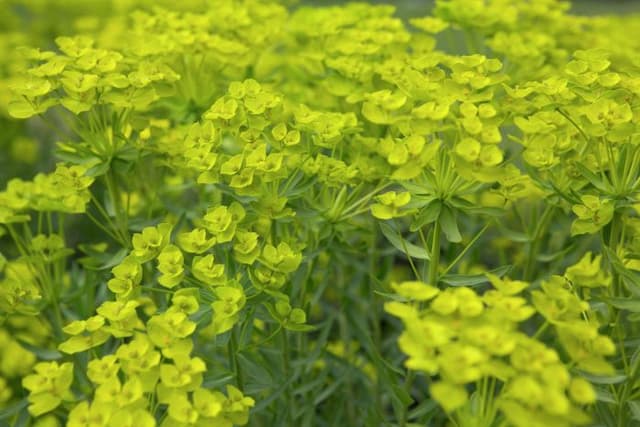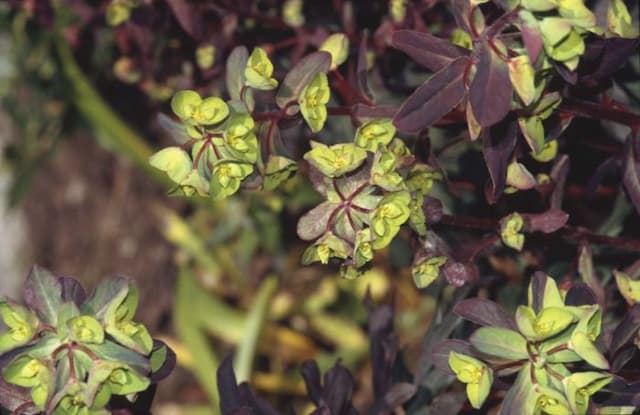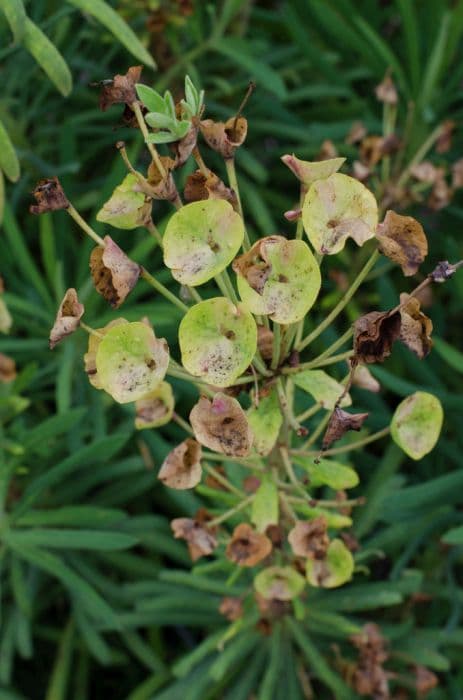Martin's Spurge Euphorbia × martini 'Kolibri'

ABOUT
Euphorbia × martini 'Kolibri', also known as Martin's spurge, presents a unique and striking appearance that makes it a favorite among garden enthusiasts. This hybrid plant features foliage in a rosette pattern that is deep green with a touch of purple flushing on the leaves. Throughout the year, this hardy perennial offers visual interest, but it truly comes into its own as the seasons change. During the blooming period, Martin's spurge produces distinctive, long-lasting flowers which are actually bracts, often mistaken for petals, that showcase a combination of lime green and bright pink colors. These bracts encase the actual tiny, insignificant flowers, and are delicately situated above the foliage, creating a vibrant contrast against the dark leaves. The vivid floral display is attractively arranged atop sturdy stems that rise above the foliage, attracting eyes and drawing attention to its dynamic form. The bracts' shape is somewhat unique, boasting an attractive combination of a rounded form with pointed tips, which adds texture and a sense of movement to plant arrangements. Martin's spurge is particularly noted for its resilience and ease of care, thriving in a variety of conditions and mingling well with other plants in mixed borders or garden settings. Striking throughout the seasons, the Martin's spurge's foliage sometimes develops red tinges as the cooler weather sets in, adding to its year-round interest. This plant, while not towering in its stature, fits comfortably into both small and large gardens due to its moderate size and is often used to bring long-lasting splashes of color and texture to the landscape. Its appearance brings a blend of Mediterranean vibrancy and architectural flair to gardens, making it both a versatile and visually appealing choice for gardeners.
About this plant
 Names
NamesFamily
Euphorbiaceae
Synonyms
Martin's Spurge, Kolibri Spurge
Common names
Euphorbia × martini 'Kolibri'
 Toxicity
ToxicityTo humans
Spurge is considered to be toxic to humans. It produces a milky sap that can cause skin irritations, and if it comes into contact with the eyes, it can cause severe pain and even temporary blindness. If ingested, the sap of spurge plants can irritate the mouth, throat, and stomach, leading to symptoms such as nausea, vomiting, and diarrhea. Ingesting large amounts can be more harmful, potentially causing more severe gastrointestinal upset, and in rare cases, can lead to more serious reactions. It is advised to handle these plants with care and to keep them out of reach of children who might accidentally ingest them.
To pets
Spurge is toxic to pets as well. It has a milky sap that can be irritating both on contact with skin and eyes or if ingested. If pets come into contact with the sap, it can cause skin rashes or inflammation. If the sap gets into their eyes, it can lead to irritation and pain. Ingestion of the plant can lead to several symptoms such as drooling, vomiting, and diarrhea. The toxicity can be particularly hazardous to pets due to their smaller body size and the likelihood of them ingesting part of the plant during play or exploration. Owners should avoid keeping this plant in easily accessible places to their pets.
 Characteristics
CharacteristicsLife cycle
Perennials
Foliage type
Evergreen
Color of leaves
Green
Flower color
Yellow
Height
1-2 feet (30-60 cm)
Spread
1-2 feet (30-60 cm)
Plant type
Shrub
Hardiness zones
6-9
Native area
Mediterranean
Benefits
 General Benefits
General Benefits- Drought Tolerance: Euphorbia × martini 'Kolibri' can survive with minimal watering once established, making it suitable for xeriscaping.
- Low Maintenance: This variety of spurge requires little care, no deadheading and can thrive on neglect.
- Deer and Rabbit Resistance: The plant's sap is unappealing to deer and rabbits, reducing the likelihood of grazing damage.
- Long Blooming Season: It offers a long season of interest with flowers from spring until fall.
- Attracts Pollinators: The flowers attract beneficial insects such as bees and butterflies.
- Ornamental Appeal: It has unique, colorful foliage and bracts, which add visual interest to gardens and landscapes.
- Adaptability: Euphorbia × martini 'Kolibri' is adaptable to a range of soil conditions, though it prefers well-drained soil.
- Compact Growth: With its moderate size, it is well-suited for borders, rock gardens, and container planting.
- Seasonal Interest: In autumn, the plant’s foliage may take on red or purple hues, enhancing its ornamental value.
 Medical Properties
Medical PropertiesThis plant is not used for medical purposes.
 Air-purifying Qualities
Air-purifying QualitiesThis plant is not specifically known for air purifying qualities.
 Other Uses
Other Uses- Euphorbia × martini 'Kolibri' can be used in floral arrangements for their unique bracts and long-lasting interest, adding texture and a touch of greenery to bouquets.
- This plant can be utilized as a natural dye source for fabrics, yielding a range of colors depending on the mordant used.
- The milky sap, although toxic, has been traditionally used as a fish stupefying agent by indigenous communities, which makes fish easier to catch.
- In arts and crafts, the dried stems and bracts can be used to create intricate natural sculptures or as elements in mixed media artwork.
- As a living mulch, it can be grown among taller plants to suppress weeds and maintain soil moisture levels with its dense foliage.
- Its suitability for xeriscaping makes it an excellent candidate for creating low water-use gardens in arid climates, conserving water resources.
- It can serve as a protective companion plant, as its toxic sap deters herbivores from nibbling on nearby more vulnerable species in the garden.
- In educational settings, it can be used to demonstrate plant adaptation and survival strategies in arid environments or as part of a pollinator garden.
- Vibrant bracts of Euphorbia x martini 'Kolibri' are sometimes used to complement the festive decorations during the holiday season.
- The plant's interesting form can inspire visual arts, using it as a live model for drawing or painting classes to teach botanical illustration.
Interesting Facts
 Feng Shui
Feng ShuiThe Spurge is not used in Feng Shui practice.
 Zodiac Sign Compitability
Zodiac Sign CompitabilityThe Spurge is not used in astrology practice.
 Plant Symbolism
Plant Symbolism- Protection: Euphorbia, often referred to as Spurge, secretes a milky sap that can be irritant, which symbolizes warding off negative energies and providing protection.
- Persistence: Being a hardy and resilient plant, Spurge symbolizes the ability to persist and thrive in challenging conditions.
- Healing: Historically, some Euphorbia species have been used for their medicinal properties, representing healing and relief from ailments.
 Water
WaterFor the Martin's Spurge, it is critical to maintain a balance in watering, as it is drought tolerant but still requires consistent moisture for optimum growth. Water the plant thoroughly when the top inch of soil feels dry, which typically might be once every 1-2 weeks, depending on the climate and the time of year. When you water, aim to apply approximately a half gallon for smaller plants to ensure the root zone is adequately moistened, adjusting as the plant grows or during periods of high heat or dry weather. Over-watering can cause root rot, so it's essential to ensure good drainage and avoid letting the plant sit in water.
 Light
LightMartin's Spurge thrives in full sun to partial shade. The ideal spot is one where it can receive at least six hours of sunlight a day. However, it is also tolerant of light dappled shade, especially in hotter climates. Avoid placing it in deep shade, as too little light can lead to poor growth and fewer flowers.
 Temperature
TemperatureMartin's Spurge can tolerate a range of temperatures but grows best when daytime temperatures are between 65°F and 75°F. While the plant can survive occasional dips to around 30°F, temperatures below this can be harmful, and it generally should not be exposed to freezing conditions. Conversely, excessive heat above 85°F can also stress the plant, so it's important to provide some shade during the hottest part of the day in warmer climates.
 Pruning
PruningMartin's Spurge benefits from pruning to remove spent flowers and encourage bushier growth. Pruning should be done in late winter or early spring, before new growth starts. Cut back the previous year's growth by about a third to promote new stems and a compact form. Always wear gloves when pruning, as the sap can be an irritant. It's also a good opportunity to remove any damaged or diseased parts of the plant.
 Cleaning
CleaningAs needed
 Soil
SoilMartin's Spurge requires well-draining soil with a mix of sand, peat, and perlite or coarse grit. Aim for a soil pH between 6.0 and 7.5 for optimal growth.
 Repotting
RepottingMartin's Spurge should be repotted every 2-3 years to refresh the soil and accommodate root growth.
 Humidity & Misting
Humidity & MistingMartin's Spurge thrives in average room humidity levels and does not require high humidity.
 Suitable locations
Suitable locationsIndoor
Place in bright light, avoiding direct intense sun.
Outdoor
Plant in full sun to partial shade, protect from harsh weather.
Hardiness zone
6-9 USDA
 Life cycle
Life cycleThe life of Martin's Spurge (Euphorbia × martini 'Kolibri') begins with seed germination, where the seeds require a warm temperature to sprout and start developing roots and shoots. As seedlings, they form true leaves and continue to grow, eventually becoming juvenile plants which develop their distinctive foliage and structure. Upon reaching maturity, Martin's Spurge produces its characteristic bracts and flowers, generally in spring, with the small actual flowers surrounded by showy, colorful modified leaves (bracts). After pollination and fertilization, the plant sets seeds, which mature and are then dispersed, sometimes by wind or with the assistance of animals. If conditions are unfavorable for seed germination, the plant can also propagate vegetatively through cuttings, which root and grow into new plants. Throughout its life cycle, this perennial will undergo periods of growth and dormancy, typically dying back in the winter and re-emerging in spring.
 Propogation
PropogationPropogation time
Spring-Early Summer
Propogation: Euphorbia × martini 'Kolibri', commonly known as Martin's Spurge, is typically propagated by cuttings. The most popular method begins by selecting healthy stems during the active growing season, which is late spring to early summer. Cuttings should be taken from new growth, making a clean cut with a sterilized knife or pair of scissors about 5 to 6 inches (12.7 to 15.24 centimeters) long. The cut end then needs to be allowed to dry and callus over for a few days to reduce the risk of rot when planted. Once callused, the cutting can be inserted into a well-draining soil mixture. Care is taken to keep the soil moist but not waterlogged, providing a warm and bright environment without direct sunlight until the roots have established. It typically takes a few weeks for the cutting to root successfully.









